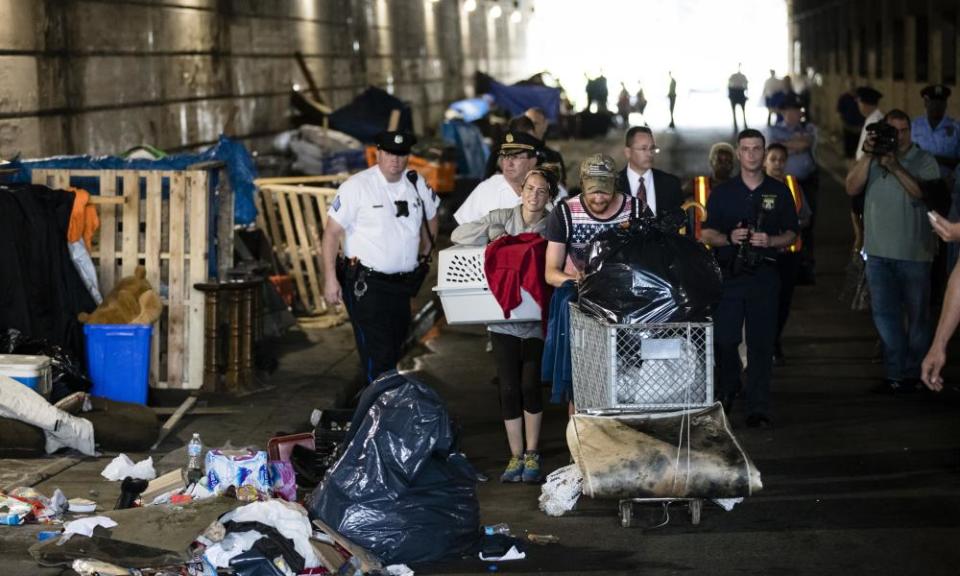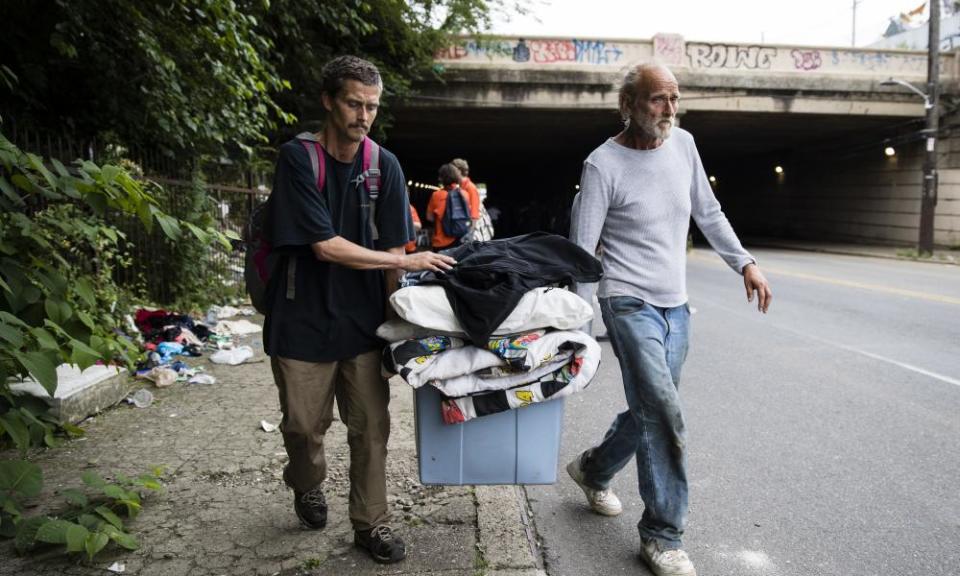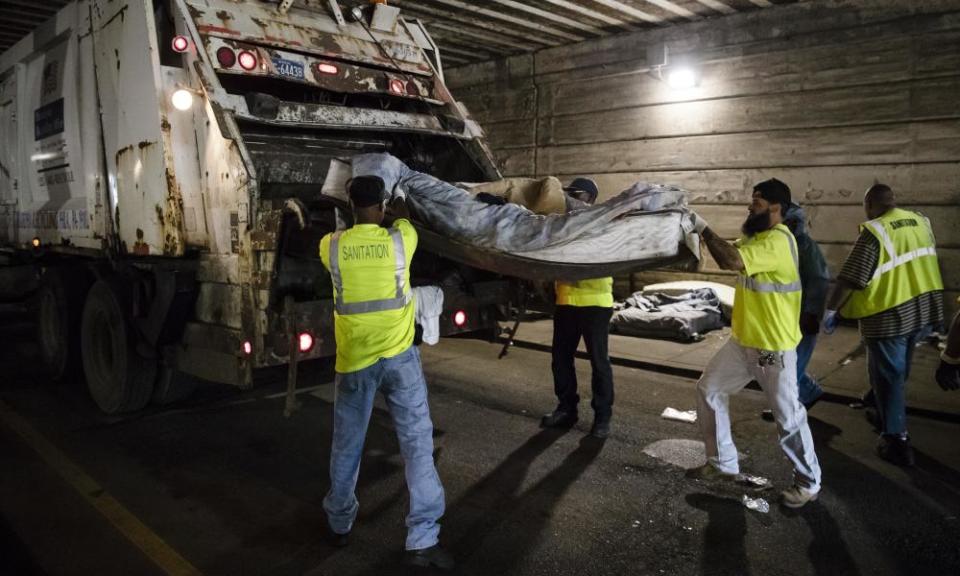How Philadelphia closed homeless 'heroin camps' amid US opioid crisis
As the epidemic moves to cities, evictions at site raise concern over loss of community and shortage of alternative housing

First came the warnings, then the deluge.
The city of Philadelphia moved to clear out two notorious underpass encampments of heroin users in the rundown Kensington district this week after a monthlong effort by city agencies and outreach groups to convince residents to seek treatment or go to shelters.
Residents have long complained that homelessness coupled with open drug use amounts to a serious public health hazard in the densely populated residential neighborhood. They welcomed the evictions on Wednesday and the removal of tents, mattresses and detritus.
The pilot program focused on connecting people to social services so they could lead more stable lives. For four weeks, social workers and police flocked to the bridges and offered help. The night before the move, some groups held prayer vigils; others, protesting the city’s action, pointed to posters that read “Eviction = Death”.
“It needed to go. It wasn’t right for kids to see that,” said a nearby resident, Lisa Kahn. “They light fires, throw their trash and dirty needles on the ground. We’re supposed to be the city of brotherly love. But they’re the ones living under a bridge, taking drugs and they’re ones getting help ...”
But the men and women who called the camps on Tulip Street and Kensington Avenue home were less than impressed. Some spoke of being pressed to accept drug detox or addiction treatment.

“They want to send everybody to rehab, but rehab is only good for people who want to go,” said Jay, 41, who was cooking heroin in preparation for a hit. Christopher, aged 29, had just taken one. He said sometimes he’d had “the gumption to go but two or three days later you don’t want to”.
Another on the avenue, who gave his name as Bruce, said he’d been using drugs in the neighborhood for 25 years.
“I live under the bridges to keep out of the elements. But I’m not ready for treatment. I’m not denying I don’t need it. I’m just not ready.” He joked that when they left the camp, he might just go sleep on the mayor Jim Kenney’s porch.
But for many, the joking has long since ended.
Tom Farley, the Philadelphia health commissioner, said there had been 1,200 fatal overdoses in the city last year, an increase of 300 over 2016, making the city one of the worst-hit in the country. Farley said that for each fatal overdose, there were probably eight to 10 non-fatal events. It is estimated that between 50,000 and 70,000 Philadelphians are addicted to opioids.
The encampments “are just one manifestation of the opioid crisis”, Farley told reporters. “Our job is to keep the people alive until they’re ready to go into treatment.”
The city’s managing director, Michael DiBerardinis, added that Philadelphia was “committed to fixing the problem. However, it won’t be easy because the opioid crisis is far from over.”
Philadelphia’s spiking opioid death rate is largely associated with fentanyl, the potent, often Chinese-manufactured, synthetic opioid. The drug is so problematic that many drug users said they chose to inject in company so they could be revived in the event of an overdose.
“We don’t see heroin around too much,” says Bruce. “Most people have switched to fentanyl. But it’s extremely dangerous. Half a nickel ($5) bag can kill you.”
Breaking down the camps could spur drug users to go back to using drugs alone.
Philadelphia officials are in discussions over setting up safe consumption sites. Farley has said he supports the measure if it saves lives. But numerous state and federal regulations make that problematic. One issue is that injecting, supervised or not, is illegal. Safe consumption sites, DiBerardinis said, were “a long way off”.
From a logistical standpoint, the city’s main issue is not a lack of treatment facilities but a shortage of alternative housing. Philadelphia’s office of homelessness services was only able to guarantee shelter for 110 people living in the encampments and who had registered as homeless early in the program.
“It’s very painful for us to say we don’t have beds for everybody, but it’s part of the reality of the homeless system,” said Liz Hersh, director of Philadelphia’s office of homeless services.
In contrast, four dozen homeless people with opioid abuse issues took the rehab option during the pilot program. Hersh described the encampments as one of the most “complex and challenging” aspects of the opioid issue, which demanded “new solutions”.
Hersh said the city had made had chosen a policy of “intensive daily outreach” and the program had begun with a voluntary assessment of 300 campers, most of whom were newly homeless. She said more had accessed treatment in the first two weeks of the program than had in the previous six months.
“As a system, this is as close as we’ve ever come to treatment on demand. That is what people have been telling us we need to have, so when people feel they are ready to seek treatment we have to be able to seize that moment.
“When we offer what people need and want, they take advantage of the opportunity,” Hersh added.
But Hersh also acknowledged that the city lacked funds to close down two other camps under bridges, on Emerald Street and Frankfort Avenue, and some displaced camp dwellers were likely to move there.

That may leave the city playing a grim game of a whack-a-mole. Some wondered if the closure of the original camp in the Gurney Street train gulch, known as El Campamento, now seemed like such a wise idea.
They point, variously, to pressures applied by the rapidly gentrifying adjacent neighborhood of Fishtown, the expansion of Temple University and Philadelphia’s pending application to become Amazon’s HQ2.
“It’s a tough issue,” the city councillor Mark Squilla said. “But to say that it’s OK for people to live in squalor, amongst urination and defecation, with human trafficking and rape that’s going on, is unconscionable to us as a city. We know that unless we take action we won’t be able to handle it. The opioid crisis is getting worse, if we don’t act on this people will be living in tents all over the city.”
But he dismissed the idea that the city was only now paying attention to the drug crisis because the camps had become a national symbol of the opioid epidemic’s rapid urbanization.
“Gentrification hasn’t reached this far,” he pointed out. “A lot of poor working people live here and they don’t want to live with this stuff going on.”
But as the two camps were dispersed, some outreach groups said they were concerned that whatever the encampments’ drawbacks, the groups had developed a sense of community and support.
Sister Betty Scanlon, who runs the nearby Community Center at Visitation, said two groups in the neighborhood, Prevention Point and Project Home, had done “a wonderful job” making sure that the homeless were safe and focusing on harm-reduction.
“We know the folks here, and we know they’re extremely vulnerable. Living here is not ideal but it’s also tough for them to lose their community.”

